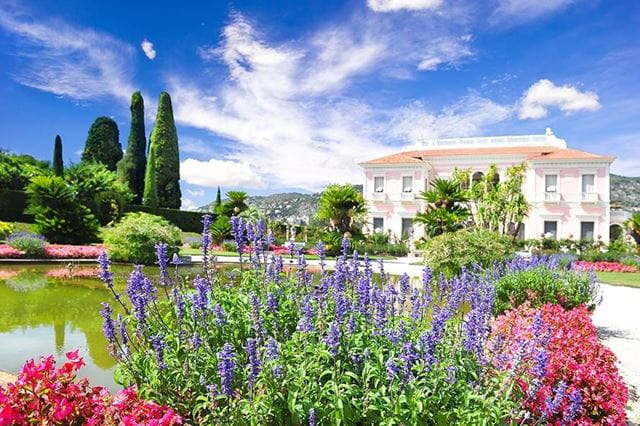
Thinking of a short break to take in one of Europe's most beautiful gardens? Yolanda Zappaterra points you in the right direction
If you've taken in Tivoli's Villa D'Este, marvelled over Monet's Giverny and gasped in awe at Versailles, where next? Here are five favourites you may not be so familiar with
Gallery
1. Gardens of the Villa Ephrussi de Rothschild, St-Jean-Cap-Ferrat, France
The southern Mediterranean is awash with stunning estates overlooking sparkling blue seas, and so to pick just one is no easy task, but we feel this very personal favourite on the Côte d'Azur won't disappoint. The pink Venetian-style Villa Ephrussi de Rothschild sets off the lush vegetation and cacti perfectly and offers some insight into the playful nature of the estate's creator, Béatrice Ephrussi (1864-1934), a Rothschild baroness.
But mostly it's the deft and delicately romantic design conjured up by Béatrice, with the help of horticultural enthusiasts like Harold Peto, Achille Duchêe, and, later, Louis Marchand. Between them, these talented garden designers and artists surrounded the villa with pretty stone and warm terracotta pathways and stairs winding their way through nine themed gardens. These include a Spanish garden in which papyrus and birds of paradise mingle around ponds contained within warm ochre walls, and an exotic one where succulents soar and spread like abstract sculptures. The contrast with its neighbouring rose garden is delightful and dramatic.
But the pièce de résistance is probably the stunning French garden, fashioned by Béatrice in the shape of a ship, complete with a Temple of Love replicating the Trianon at Versailles at its bow with dancing fountains creating constant sound and movement among the palm trees, flowerbeds and lily ponds.
Where is it: 06230 Saint-Jean-Cap-Ferrat, France, +33 04 93 01 33 09.
Fly to: Granada airport - 20 miles away.
2. Villa Lante, Viterbo, Tuscany, Italy
The Renaissance gardens of Italy are probably best exemplified by those of the Villa D'Este at Tivoli, but their sheer popularity can seriously undermine the appreciation of their formal beauty and design.
The late-16th-century Villa Lante in Bagnaia, by contrast, is as arresting now as it was when it was visited by Pope Gregory XIII over 400 years ago: he was so taken by its frescoes, elaborate fountains, terraces and water features that he cut owner Cardinal Gianfrancesco Gambara's allowance, halting work on the site. On Gambara's death in 1587 the villa's next owner, the 17-year-old cardinal Alessandro Peretti di Montalto, continued to enlarge the site with a house and garden that mirrored Gambara's vision to create a unified whole. With its perfect proportions, rich details and formal planting, it is one of the best examples of Mannerist Renaissance design in Italy.
Where is it: Via Jacopo Barozzi 71, 01100 Bagnaia, Viterbo, +39 0761 288008, 5km outside Viterbo on Route 205.
Fly to: Rome's Fiumicino Airport, which is 40 miles away. Flights from Gatwick, London Luton and Manchester, among other UK airports.
3. Monserrate Palace Gardens, Sintra, Portugal
The playful and rather surreal blend of Indian, Arabian and Moorish Spanish architecture in this 19th-century palace extend into gardens that are a real delight. If Monserrate Palace Gardens reminds you of the excesses of Brighton Pavilion, that's because its English owner and wealthy industrialist Sir Francis Cook brought in Victorian polymath James Knowles to remodel it when he acquired the site in 1858, and drew also his own many influences from buildings and styles he'd admired in his travels.
The wonderful jumble continues out to the chaotic but charming gardens, where Cook called on the services of other fellow Englishmen, including landscape artist William Stockdale, gardener James Burt, and botanist William Nevill, to create a handsome estate. Here you'll find not just an English lawn but replica Temple ruins, lakes, waterfalls, woodland walks, a huge collection of roses, indigenous plants and borders containing more than 2,500 exotic species of plants from as far afield as Mexico and Japan.
Where is it: Estrada de Monserrate 2710-405 Sintra, +351 21 923 7300, around four kilometres outside Sintra old town.
Fly to: Lisbon – Sintra is 20 miles west of the city.
4. Generalife Gardens, Granada, Spain
Part of and adjacent to the Alhambra Palace, and once linked to it via a covered walkway, the Generalife Gardens take a back seat to the splendours of the palace itself, which can be so exhausting that you might be tempted not to bother with the gardens. That would be a shame: these 14th-century gardens, the oldest surviving Moorish gardens in Europe and part of a summer leisure estate for the sultans and their families, are not only beautifully designed and planted, but their plateau setting and Sierra Nevada mountain views are breathtaking.
The formal layout and elegant water features give them a Renaissance feel, and indeed the estate has seen radical alterations over the centuries. Mixed with the more fanciful and decorative Moorish style, and threaded through with lots of colourful planting, rose-covered pergolas and walls tumbling with wisteria, the total effect is just as breathtaking as the nearby Alhambra.
Make for the central courtyard patio (Patio de la Acequia), the 48m-long garden that includes not just the central water feature, but also elegant arched porticoes, columns and various pavilions, to explore landscaping that spans more than 500 years.
Where is it: Paseo del Generalife, 18009 Granada, Spain
Fly to: Granada Airport.
5. The Orto Botanico di Padova, Padua, Italy
This one's a real horticulturalist's heaven, but that doesn't mean general garden lovers won't find a huge amount to enjoy in the enthralling botanical garden at the Orto Botanico de Padova – the oldest in the world still in its original location and a UNESCO World Heritage Site since 1997.
Since its creation in 1545, when it was part of the Republic of Venice, the garden has been a teaching space. Originally for the study of plants and their medicinal properties, now it draws students and visitors alike to examine its 3,500 plus plant species and features like the 300-year-old walls, built to stop acquisitive botanists and horticulturalists making off with its rare plants - despite penalties that included prison or exile if they were caught.
Plants are largely contained within two gardens: a historical one that contains such curiosities as Goethe's Palm, housed in a lovely hexagonal greenhouse. Dating from 1585, it is the oldest tree in the garden; a new biodiversity garden opened last year on unused Benedictine vegetable gardens to create a series of greenhouses that showcases planting across four climatic zones.
Where is it: Via Orto Botanico 15, 35123 Padova, + 39 049 827 2119,
Fly to: Venice Marco Polo (30 miles away) or Treviso (40 miles away).









